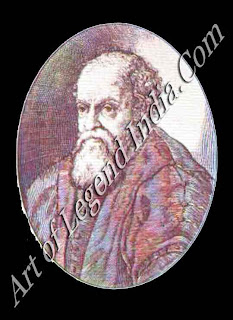 Annibale`s Bologna
Annibale`s Bologna
A
flourishing centre for the arts, Bologna was renowned for its colourful
festivals and gastronomic excellence. But underlying this 'prosperity' there
was widespread poverty and public unrest.
During
the last three decades of the 16th century, when the Carracci were at the
height of their activity, the busy and populous city of Bologna was one of the
most important cultural and economic centres in Europe. In 1587, the city's
population numbered 72,000, a level which was not reached again until 1791;
industry and commerce were slowly expanding and the ancient university
continued to prosper, attracting such influential scholars as Ulisse
Aldrovandi. In 1582, the city's importance as a centre of religious life was
formally acknowledged when Pope Gregory XIII created Bologna an archbishopric.
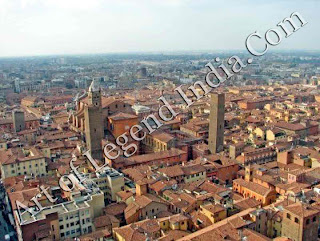 Most
important of all, the late 16th century saw an unprecedented flowering of
activity in the arts. The Carracci's Accademia degli Incamminati, which established
Bologna as a leading centre of painting in Europe was just one among a host of
cultural and scientific societies which sprang up in the city. Bologna's church
of San Petronio, one of the largest in the world, was renowned as a centre of
musical activity. Its unusual size and superb acoustics encouraged the
employment of massive groups of musicians, whose activities were to play an
important part in the development of the Baroque concerto form. At the same
time, the cappella musicale, or music academy, saw the emergence of a stream of
talented composers.
Most
important of all, the late 16th century saw an unprecedented flowering of
activity in the arts. The Carracci's Accademia degli Incamminati, which established
Bologna as a leading centre of painting in Europe was just one among a host of
cultural and scientific societies which sprang up in the city. Bologna's church
of San Petronio, one of the largest in the world, was renowned as a centre of
musical activity. Its unusual size and superb acoustics encouraged the
employment of massive groups of musicians, whose activities were to play an
important part in the development of the Baroque concerto form. At the same
time, the cappella musicale, or music academy, saw the emergence of a stream of
talented composers.
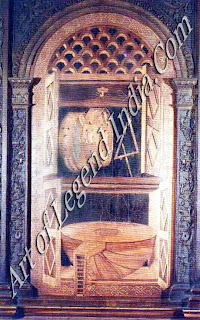 The
city's prosperity was largely the result of a long period of internal peace. In
1512, Pope Julius II had finally expelled from the city the ruling family of
Bentivoglio, and reclaimed Bologna as part of the Papal States. From that time
onwards, the city was governed jointly by an elected Senate of 40 men, drawn
from the local nobility, and a resident papal legate, or Legato. This unusual
form of government had its drawbacks, but it ensured a state of relative
tranquillity, and contributed to the distinctive character of the city's public
life.
The
city's prosperity was largely the result of a long period of internal peace. In
1512, Pope Julius II had finally expelled from the city the ruling family of
Bentivoglio, and reclaimed Bologna as part of the Papal States. From that time
onwards, the city was governed jointly by an elected Senate of 40 men, drawn
from the local nobility, and a resident papal legate, or Legato. This unusual
form of government had its drawbacks, but it ensured a state of relative
tranquillity, and contributed to the distinctive character of the city's public
life.
In
reality, the power of the Senate was considerably restricted by the presence
and authority of the Legato. Outwardly however, the senators attempted to create
the impression that they were successfully protecting the autonomy of the
Bolognese republic from the tyranny of Papalrule. The Carracci's frescoes of
the story of Romulus and Remus in the Palazzo Magnani, painted at the time when
the Magnani family were readmitted to the Senate after their exclusion by Pope
Leo X, can be seen as one expression of this republican spirit.
In
public, the senators surrounded themselves with all the trappings of status and
power, living lives of ostentatious luxuiy. Despite the passing of numerous
sumptuary laws, they dressed in the finest clothes and held endless banquets.
To reinforce their image, they organized festivals, tournaments and jousts. The
two-monthly election of the Gonfaloitiere di Giustizia (standard-bearer of
justice) was marked by an elaborate ceremony, accompanied by regular
processions and feasts. These sumptuous festivities, surpassed in extravagance
by few cities in Europe, combined with other religious celebrations to give
Bologna an unusually active and colourful public life.
GASTRONOMIC INDULGENCE
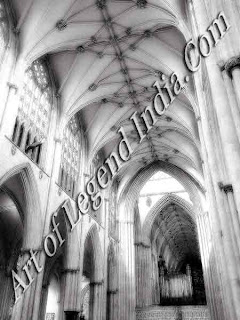 The
love of luxury and good living, and particularly of good food, was not confined
to the nobility. According to contemporary historians, the common people were
also given to bouts of over-indulgence, and feasted extensively at the end of
the week 'consuming in one day alone what they had earned with the sweat of
six'.
The
love of luxury and good living, and particularly of good food, was not confined
to the nobility. According to contemporary historians, the common people were
also given to bouts of over-indulgence, and feasted extensively at the end of
the week 'consuming in one day alone what they had earned with the sweat of
six'.
Bologna
has long been renowned as a centre of fine cuisine, and even today is known as
the gastronomic centre of Italy. Located in one of the most fertile regions of
the country, Bologna produces a cuisine which is rich in dairy products and
high quality meats. Best known for the invention of rapt, the rich meat sauce
which forms the basis of spaghetti bolognaise, the city can also claim to have
invented a number of other pasta dishes, such as lasagne and tortellini.
The
prosperity of Bologna was perhaps most dearly reflected in the extensive
building boom which began around the second decade of the century, and which
transformed the city into one of the most beautiful and richly varied in Italy.
The bustling medieval streets, with their distinctive covered arcades, became
punctuated by elegant new churches and palaces, based largely on contemporary
Roman models. 1562 saw the beginning of the Archiginnasio, an imposing new
building designed to bring together the scattered faculties of the University.
Two years later, the medieval Piazza Maggiore, the heart of city life, was
embellished by the construction of the adjacent Piazza del Nettuno, with its
spectacular bronze fountain by the sculptor Giambologna. Senators vied with
each other in constructing magnificent palaces with elaborate facades, as
concrete symbols of their power. And new areas of the city were built up within
the 13th-century walls, to accommodate the growing population.
ENLIGHTENED REFORM
 During
the years of the Carracci, Bologna was an important centre of religious reform.
Under the enlightened direction of its bishop, Cardinal Gabriele Paleotti, the
proposals of the Council of Trent for the reinvigoration of the Catholic Church
were given new impetus. Paleotti founded a seminary for the training of
priests, insisting on the importance of the clergy in setting an example in
moral and religious behaviour. He also founded a number of charitable
institutions, including the Magistrato della Concordia, a committee of lay and
religious people designed to give free legal advice and assistance to citizens
of limited means.
During
the years of the Carracci, Bologna was an important centre of religious reform.
Under the enlightened direction of its bishop, Cardinal Gabriele Paleotti, the
proposals of the Council of Trent for the reinvigoration of the Catholic Church
were given new impetus. Paleotti founded a seminary for the training of
priests, insisting on the importance of the clergy in setting an example in
moral and religious behaviour. He also founded a number of charitable
institutions, including the Magistrato della Concordia, a committee of lay and
religious people designed to give free legal advice and assistance to citizens
of limited means.
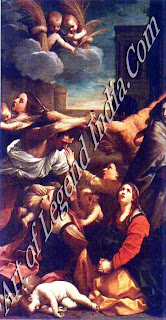 Despite
the surface festivity however, city life in Bologna had strong undercurrents of
violence and unrest. While the senators prospered, life for the common folk was
unremittingly harsh. The stagnating economy of the country as a whole,
exorbitant taxation and a series of poor harvests brought widespread poverty
and outbreaks of crime. 1588 saw the beginning of a series of food shortages
which left innumerable people dying of hunger in the city's streets. The same
year, a rise in the price of bread lead to riots in the city, culminating in
the arrest of over 100 bakers, butchers and rebels. Between 1587 and 1595 the
population fell by 13,000.
Despite
the surface festivity however, city life in Bologna had strong undercurrents of
violence and unrest. While the senators prospered, life for the common folk was
unremittingly harsh. The stagnating economy of the country as a whole,
exorbitant taxation and a series of poor harvests brought widespread poverty
and outbreaks of crime. 1588 saw the beginning of a series of food shortages
which left innumerable people dying of hunger in the city's streets. The same
year, a rise in the price of bread lead to riots in the city, culminating in
the arrest of over 100 bakers, butchers and rebels. Between 1587 and 1595 the
population fell by 13,000.
Public
order was also a serious problem. Although organized protest against conditions
was rare, theft and murder were common in the city, and contemporary chronicles
record each day's events as a bizzare combination of high festivities, ghastly
murders and public executions. The problem was most severe in the surrounding
countryside, where unemployed soldiers formed groups of bandits who looted,
raped and murdered. Often these bandits were sheltered by the nobility, who
used them to protect their own family and territorial interests. In 1585, the
Pope ordered the murder of the count and senator Giovanni Pepoli, who refused
to hand over a notorious bandit found on his territory; in deference to his
aristocratic status, the count was strangled with a silk noose. Among other
things, the count's execution was intended to serve as a warning to the
nobility, who tried to exert their authority in defiance of Rome.
By the
time Annibale Carracci died, the golden years of Bologna were over. The 17th
century witnessed the city's gradual decline, exacerbated by the calamitous
outbreak of plague in 1630, which left one quarter of the population dead. But
for Annibale, the city must have provided a sympathetic and stimulating
environment, with rich and varied patronage, active intellectual debate, and a
feast of luxurious spectacle.
Writer
– Marshall Cavendish
 Most
important of all, the late 16th century saw an unprecedented flowering of
activity in the arts. The Carracci's Accademia degli Incamminati, which established
Bologna as a leading centre of painting in Europe was just one among a host of
cultural and scientific societies which sprang up in the city. Bologna's church
of San Petronio, one of the largest in the world, was renowned as a centre of
musical activity. Its unusual size and superb acoustics encouraged the
employment of massive groups of musicians, whose activities were to play an
important part in the development of the Baroque concerto form. At the same
time, the cappella musicale, or music academy, saw the emergence of a stream of
talented composers.
Most
important of all, the late 16th century saw an unprecedented flowering of
activity in the arts. The Carracci's Accademia degli Incamminati, which established
Bologna as a leading centre of painting in Europe was just one among a host of
cultural and scientific societies which sprang up in the city. Bologna's church
of San Petronio, one of the largest in the world, was renowned as a centre of
musical activity. Its unusual size and superb acoustics encouraged the
employment of massive groups of musicians, whose activities were to play an
important part in the development of the Baroque concerto form. At the same
time, the cappella musicale, or music academy, saw the emergence of a stream of
talented composers.  The
city's prosperity was largely the result of a long period of internal peace. In
1512, Pope Julius II had finally expelled from the city the ruling family of
Bentivoglio, and reclaimed Bologna as part of the Papal States. From that time
onwards, the city was governed jointly by an elected Senate of 40 men, drawn
from the local nobility, and a resident papal legate, or Legato. This unusual
form of government had its drawbacks, but it ensured a state of relative
tranquillity, and contributed to the distinctive character of the city's public
life.
The
city's prosperity was largely the result of a long period of internal peace. In
1512, Pope Julius II had finally expelled from the city the ruling family of
Bentivoglio, and reclaimed Bologna as part of the Papal States. From that time
onwards, the city was governed jointly by an elected Senate of 40 men, drawn
from the local nobility, and a resident papal legate, or Legato. This unusual
form of government had its drawbacks, but it ensured a state of relative
tranquillity, and contributed to the distinctive character of the city's public
life.  The
love of luxury and good living, and particularly of good food, was not confined
to the nobility. According to contemporary historians, the common people were
also given to bouts of over-indulgence, and feasted extensively at the end of
the week 'consuming in one day alone what they had earned with the sweat of
six'.
The
love of luxury and good living, and particularly of good food, was not confined
to the nobility. According to contemporary historians, the common people were
also given to bouts of over-indulgence, and feasted extensively at the end of
the week 'consuming in one day alone what they had earned with the sweat of
six'.  During
the years of the Carracci, Bologna was an important centre of religious reform.
Under the enlightened direction of its bishop, Cardinal Gabriele Paleotti, the
proposals of the Council of Trent for the reinvigoration of the Catholic Church
were given new impetus. Paleotti founded a seminary for the training of
priests, insisting on the importance of the clergy in setting an example in
moral and religious behaviour. He also founded a number of charitable
institutions, including the Magistrato della Concordia, a committee of lay and
religious people designed to give free legal advice and assistance to citizens
of limited means.
During
the years of the Carracci, Bologna was an important centre of religious reform.
Under the enlightened direction of its bishop, Cardinal Gabriele Paleotti, the
proposals of the Council of Trent for the reinvigoration of the Catholic Church
were given new impetus. Paleotti founded a seminary for the training of
priests, insisting on the importance of the clergy in setting an example in
moral and religious behaviour. He also founded a number of charitable
institutions, including the Magistrato della Concordia, a committee of lay and
religious people designed to give free legal advice and assistance to citizens
of limited means.  Despite
the surface festivity however, city life in Bologna had strong undercurrents of
violence and unrest. While the senators prospered, life for the common folk was
unremittingly harsh. The stagnating economy of the country as a whole,
exorbitant taxation and a series of poor harvests brought widespread poverty
and outbreaks of crime. 1588 saw the beginning of a series of food shortages
which left innumerable people dying of hunger in the city's streets. The same
year, a rise in the price of bread lead to riots in the city, culminating in
the arrest of over 100 bakers, butchers and rebels. Between 1587 and 1595 the
population fell by 13,000.
Despite
the surface festivity however, city life in Bologna had strong undercurrents of
violence and unrest. While the senators prospered, life for the common folk was
unremittingly harsh. The stagnating economy of the country as a whole,
exorbitant taxation and a series of poor harvests brought widespread poverty
and outbreaks of crime. 1588 saw the beginning of a series of food shortages
which left innumerable people dying of hunger in the city's streets. The same
year, a rise in the price of bread lead to riots in the city, culminating in
the arrest of over 100 bakers, butchers and rebels. Between 1587 and 1595 the
population fell by 13,000. 











0 Response to "Italian Great Artist Annibale Carracci - Annibale`s Bologna"
Post a Comment